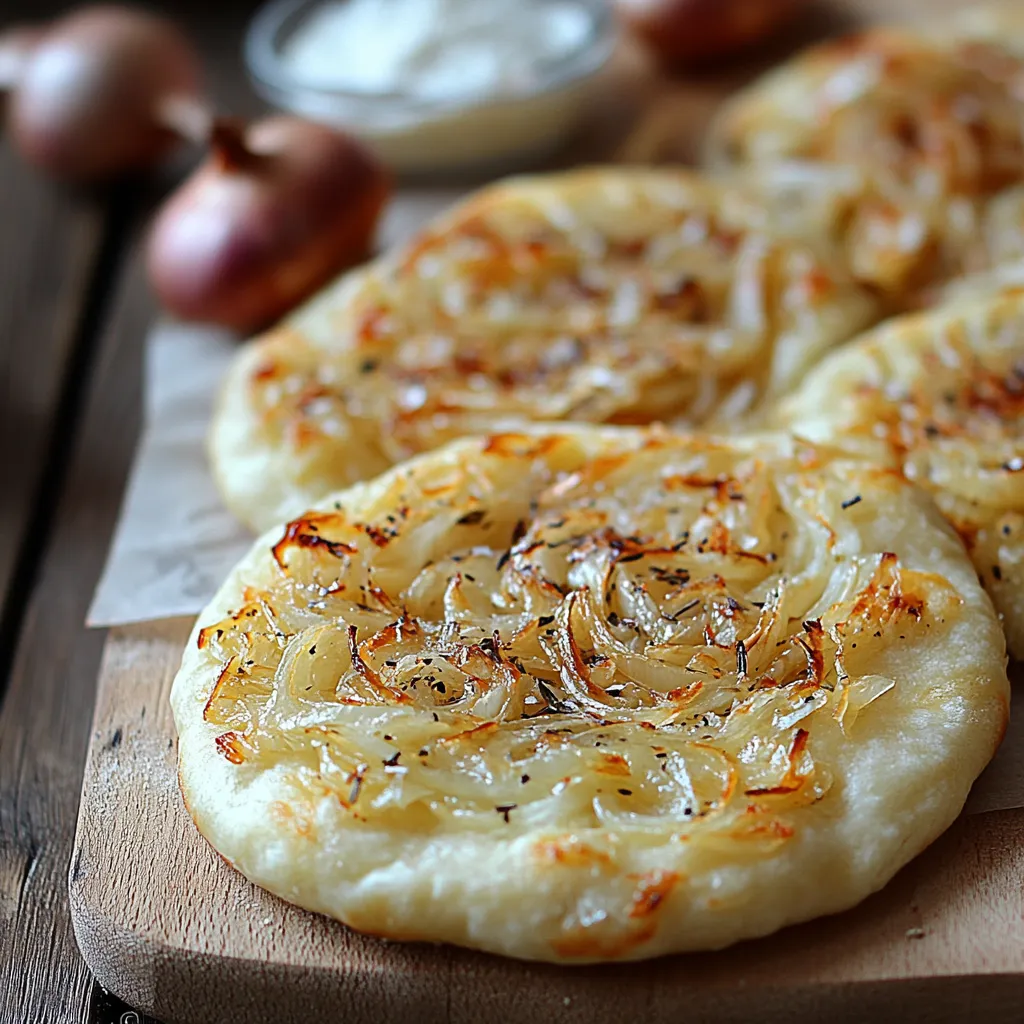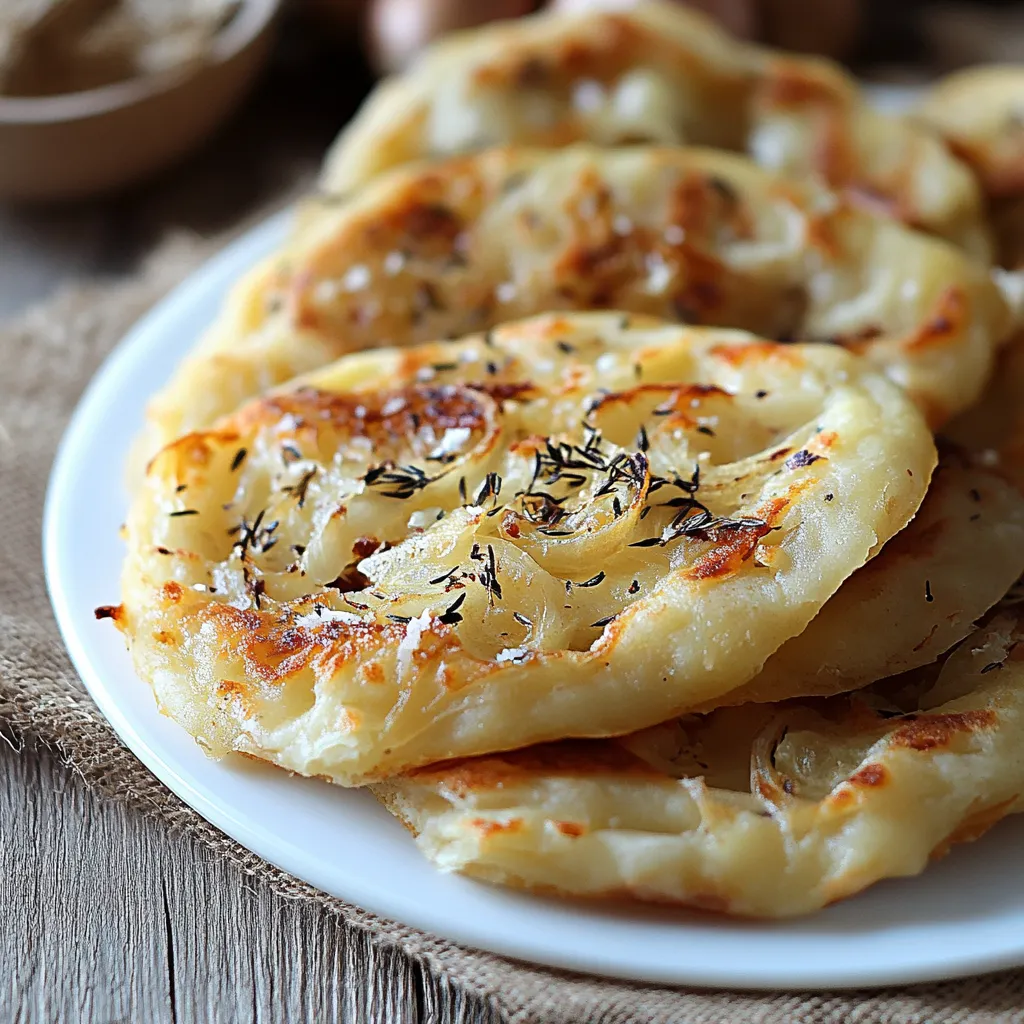 Pin it
Pin it
Traditional Polish onion flatbreads deliver exceptional flavor through simple ingredients transformed by careful preparation and patient baking. These golden discs feature a perfectly chewy crust topped with sweet caramelized onions and nutty poppy seeds, creating remarkable depth from minimal components. Originating from the Lublin region of eastern Poland, this humble bread carries cultural significance while providing universal appeal through its satisfying texture and comforting flavor profile. Perfect for casual snacking or alongside hearty soups, these versatile flatbreads bridge everyday sustenance and special occasion appeal with straightforward preparation that yields impressive results.
I discovered this recipe while researching my Polish heritage, seeking connections to family culinary traditions that had faded over generations. After experimenting with various preparation methods and onion cooking techniques, this version consistently evokes the traditional flavors I remembered from childhood visits to Polish relatives. My husband, initially skeptical about onion bread, now requests these flatbreads regularly alongside weekend soups. The most meaningful endorsement came when my Polish grandmother recognized the aroma immediately during a visit, sharing stories about how her mother made similar breads every Friday, confirming the authentic character of this recreation.
Quality Ingredients
- All-purpose flour: Creates proper structure with ideal chew when properly kneaded
- Active dry yeast: Provides reliable rising with classic bread flavor development
- Granulated sugar: Feeds yeast activity while contributing subtle background sweetness
- Fresh yellow onions: Transform completely through caramelization into sweet savory topping
- Poppy seeds: Add visual contrast, textural interest, and subtle nutty flavor
- Vegetable oil: Introduces necessary fat content for tender crumb without competing flavors
- Table salt: Enhances both dough and onion flavors through precise seasoning
- Black pepper: Adds gentle warmth that complements caramelized onion sweetness
Cooking Instructions
- Activate The Yeast:
- Combine lukewarm water with sugar and sprinkle yeast over the surface. Let sit for eight minutes until foamy.
- Develop Proper Dough:
- Mix flour and salt, then add the activated yeast mixture and vegetable oil. Stir until a shaggy dough forms, then knead for 8-10 minutes until smooth and elastic.
- Allow First Rising:
- Place kneaded dough in an oiled bowl, cover, and let rise for about one hour until doubled in volume.
- Prepare Onion Topping:
- Sauté finely chopped onions in vegetable oil over medium-low heat for 18 minutes until caramelized. Season with salt and black pepper, then let cool.
- Shape The Flatbreads:
- Punch down dough and divide into eight equal portions. Roll each into a 6-inch circle and transfer to a parchment-lined baking sheet.
- Apply Toppings And Bake:
- Top each dough round with caramelized onions, sprinkle with poppy seeds, and let rest for 15 minutes. Bake at 400°F for 18 minutes until golden brown.
 Pin it
Pin it
I learned through multiple attempts that allowing the shaped flatbreads to rest briefly before baking makes an enormous difference in the final texture. My teenage son now helps prepare these by caramelizing onions while I handle the dough, making this a collaborative kitchen project.
Perfect Pairings
Serve alongside hearty Polish soups like żurek or bean soup. Pair with cured meats and pickled vegetables for an Eastern European grazing board. Enjoy as a breakfast dish topped with soft scrambled eggs and herbs.
Creative Variations
Incorporate cooked bacon bits for a Lithuanian twist. Add dill and caraway seeds for Ukrainian influence. Try roasted red peppers or sautéed mushrooms for a modern take.
Storage Solutions
Wrap in kitchen towels and store at room temperature for two days. Refrigerate in airtight containers for up to five days and reheat in a 350°F oven. Freeze for up to three months and reheat before serving.
Cultural Significance
Cebularz Lubelski originated in Jewish communities of Lublin in the 19th century. Now a protected regional specialty, it represents culinary tradition passed through generations.
 Pin it
Pin it
The enduring appeal of cebularz lubelski lies in its simplicity and cultural connection. Watching someone take their first bite and recognizing its nostalgic aroma makes sharing this recipe deeply rewarding.
Frequently Asked Questions
- → Can I make the dough ahead of time?
- Yes, you can prepare the dough a day ahead. After kneading, place it in a greased bowl, cover with plastic wrap, and refrigerate overnight. The next day, let it come to room temperature for about 30 minutes before shaping and adding toppings.
- → What can I use instead of poppy seeds?
- If you don't have poppy seeds, you can substitute sesame seeds, nigella seeds, or even a sprinkle of coarse sea salt. Each will provide a different flavor profile but will work well with the caramelized onions.
- → Can I add other toppings to this flatbread?
- Absolutely! This flatbread is versatile - try adding crumbled goat cheese, fresh herbs like rosemary or thyme, sliced olives, or even a drizzle of honey after baking for a sweet and savory combination.
- → How do I store leftover flatbread?
- Store cooled flatbread in an airtight container at room temperature for up to 2 days. For longer storage, wrap individual pieces in plastic wrap, place in a freezer bag, and freeze for up to 1 month. Reheat frozen flatbread in a 350°F oven until warmed through.
- → Can I use instant yeast instead of active dry yeast?
- Yes, you can use instant yeast in place of active dry yeast. Use the same amount (7g) but you can mix it directly with the dry ingredients without needing to dissolve it in water first. The rising time might be slightly shorter with instant yeast.
